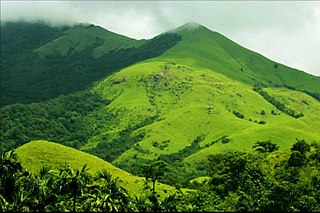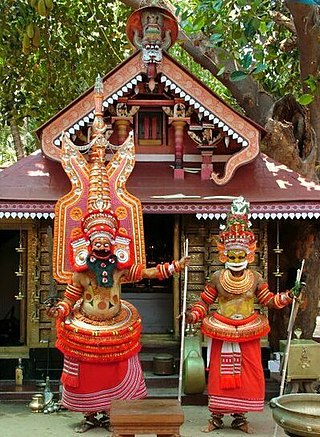Igguthappa is a Kodava deity worshipped in Kodagu, India. [1]

Igguthappa is a Kodava deity worshipped in Kodagu, India. [1]

The Kodava God of the Kodava Tribe, Legend has it that in ancient times from what is now Kerala arrived seven celestial children. [1] They were siblings, six brothers (including Igguthappa) and one sister. The first 3 brothers stayed back in Kerala in and around what is known as Kanjirath village, in Taliparamba. The eldest brother was known as Kanyaratappa (Kanyarat was a name for Kanjirath), the second was Thiruchembarappa and the third was Bendru kolappa, known by the names of the villages they settled down in and where temples were built for them. The temples built for the three brothers are now famous in Kannur in Kerala.
The remaining three brothers with their sister moved towards Kodagu. [2]
The Kodava is a Dravidian language spoken in Kodagu district (Coorg) in Southern Karnataka, India. It is an endangered The term Kodava has two related usages. Firstly, it is the name of the Kodava language and culture followed by a number of communities from Kodagu. Secondly, within the Kodava-speaking communities and region (Kodagu), it is a demonym for the dominant Kodava people. Hence, the Kodava language is not only the primary language of the Kodavas but also of many other castes and tribes in Kodagu. The language has two dialects: Mendele and Kiggat.

Kodagu district is an administrative district in the Karnataka state of India. Before 1956, it was an administratively separate Coorg State, at which point it was merged into an enlarged Mysore State.

Madikeri is city and headquarters of Kodagu district in the Karnataka state of India. It is recognised as one of the world's eight "hottest hotspots" of biological diversity and also one of UNESCO World Heritage Sites.

The Kodava people or Kodavas or Codavas are an endogamous Dravidian ethno-linguistic group from the region of Kodagu in the southern Indian state of Karnataka, who natively speak the Kodava language. They are traditionally land-owning agriculturists and patrilineal, with martial customs. Kodavas worship ancestors and weapons. They used to worship swords, bows, arrows and later guns. Hence, Kodavas are the only ones in India permitted to carry firearms without a license.

Brahmagiri, is a mountain range in the Western Ghats of south India. It is situated on the border between Kodagu district in Karnataka state in the north and Wayanad district of Kerala state on the south. Brahmagiri Hill, at 1608 m height, near Tirunelli is a scenic tourist attraction. The top of Brahmagiri Hill is well forested and has much wildlife. Talakaveri is located on the northern section of the range, near Bhagamandala in Kodagu district (Coorg), in the South Indian state of Karnataka.

Muthappan is a deity commonly worshiped in the Kannur, Kasargod, Kozhikode, Malappuram region of Kerala and Coorg region of Karnataka in India. Muthappan is considered as the personification of two Hindu gods — the Thiruvappan or Valiya Muthapan (Vishnu) and the Vellatom or Cheriya Muthapan (Shiva).
Kunnathur Padi is the historic center for the folk Hindu deity Sree Muthappan. The center stands in Payyavoor Grama Panchayat, Kannur District of the Kerala state of India, 3,000 feet above sea level, on top of Udumbumala in the Sahyadri mountains. The region belonged to the kingdom of the Mannanar dynasty, the line of Muttappan. In 1902, Kunhikelapan Mannanar, the last king of this dynasty of Muthappan's clan, was killed and the British government seized the property of this dynasty, and Karakattidam Nayanar, a Nair landlord, got the right to manage Kunnathur Padi.

Chikavira Rajendra or Chikka Vira Rajendra, was the last ruler of the Kodagu (Coorg) kingdom in South India. His actual name was Vira Rajendra, but this was the name of his uncle as well; as both of them were rulers of Kodagu, the prefix Chikka is used as a distinguisher. He was a son of Linga Rajendra II.

Ulikkal is a growing town in Kannur District in Kerala. It is the HQ of Ulikkal Grama Panchayat in Iritty Taluk. Kerala State Hill highway SH 59 passes through Ulikkal Town.

The district of Kodagu in present-day Karnataka comprises the area of the former princely state of the same name.

Bhagamandala is a pilgrimage place in Kodagu district of the Indian state of Karnataka.

Nalknad Palace or Nalkunadu, called Naalnaad Aramane in the local Kodava language, is a palace located in the Kodagu district of the Indian state of Karnataka. It is located near a village named Yavakapadi and was built between the years 1792 and 1794 AD. This palace was the last refuge of the last of the Haleri kings of Kodagu, Chikka Veerarajendra before he was deposed by the British. The Kannada film Shanti, which has only a single actor, was shot in the surroundings of the palace.

Ponnampet is a taluk headquarters in the southern part of the district of Kodagu in the state of Karnataka.Ponnampet taluk came into existence on 29 November 2020.

Appachcha Kavi was an Indian poet and playwright. He belonged to the Kodava community and is known as the first playwright in the Kodava language.
There are places of worship considered important in the Kannur district. Kannur District is one of the 14 districts in the state of Kerala, India. The town of Kannur is the district headquarters, and gives the district its name.
The captivity of Kodavas (Coorgis) at Seringapatam was the period of capture, deportation, and imprisonment of Kodava Takk speaking kodavas who rebelled against Tippu Sultan, the de facto ruler of the Kingdom of Mysore, they (60,000-70,000) were caught during a number of attempts to suppress their rebellion in the 1780s.
Nadikerianda Chinnappa (1875–1931) was an Indian compiler, poet, translator, army man, police officer, cricket player, singer and philanthropist from Kodagu.

The Pattole Palame is a compilation of Kodava folksongs first published in 1924. It was compiled by Nadikerianda Chinnappa.
Kalyatanda Ponnappa was a 17th-century warrior of Kodagu (Coorg). Since he was deified after his death, the people of Kodagu consider him to be a god. He is also known as Kaliat-Achchappa or Kaliat Ajjappa.